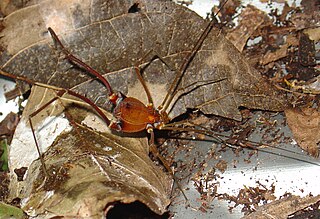
The Opiliones are an order of arachnids, colloquially known as harvestmen, harvesters, harvest spiders, or daddy longlegs. As of July 2024, over 6,650 species of harvestmen have been discovered worldwide, although the total number of extant species may exceed 10,000. The order Opiliones includes five suborders: Cyphophthalmi, Eupnoi, Dyspnoi, Laniatores, and Tetrophthalmi, which were named in 2014.

Gonyleptidae is a neotropical family of harvestmen with more than 800 species, the largest in the suborder Laniatores and the second largest of the Opiliones as a whole. The largest known harvestmen are gonyleptids.

Cosmetidae is a family of harvestmen in the suborder Laniatores. With over 700 species, it is one of the largest families in Opiliones. They are endemic of the New World with a Nearctic-Neotropical distribution where a large fraction of the diversity of Opiliones are represented by this single family. Cosmetidae have the northern extent of their range into the USA, where a small number species occur in the southern states. However, the family is especially diverse in Mexico, Central America and northern South America; especially the Andean realms. Their range also extends further south into Argentina and southern Brazil, but they are absent in Chile. Cosmetidae are prevalent in Amazonian region, but only relatively few also occur in Brazilian Atlantic Forest. Several species are also found in the Caribbean.

The Neogoveidae are a family of harvestmen with 27 described species in eight genera. However, eight species of Huitaca, 17 species of Metagovea and 12 species of Neogovea are currently awaiting description.
The Stygnopsidae are a small family of harvestmen, with almost all species found in Mexico.

The Stygnidae are a family of neotropical harvestmen within the suborder Laniatores.

The Cranaidae are a family of neotropical harvestmen within the suborder Laniatores.
Escadabiidae is a small neotropical family of the harvestman infraorder Grassatores with six described species.
The Fissiphalliidae are a small monotypic neotropical family of harvestmen within the suborder Laniatores, superfamily Zalmoxoidea. It contains only the single genus FissiphalliusMartens, 1988 with seven described species. All species are found in the South America.
Yania is a genus of harvestmen from South America. Yania flavolimbata is the only species in the monotypic genus Yania. It was first described by Roewer, 1914.
Eutimesius is a genus of harvestmen in the family Stygnidae with five described species. All species are found in South America.
Paramiopsalis is a genus of harvestmen belonging to the family Sironidae. All species are found in Spain.
Parasiro is a genus of harvestmen belonging to the family Parasironidae with one described species. It is found in Southwestern Europe.
Holcobunus is a genus of the order Opiliones in the family Sclerosomatidae. The genus was first described by Roewer, 1910
Asarcus is a genus of harvestmen in the family Gonyleptidae with four described species. All species are found in Brazil.
Bourguyia is a genus of harvestmen in the family Gonyleptidae with four described species. All species are found in Brazil.
Tirrenosiro is a genus of harvestmen in the suborder Cyphophthalmi with two described species. Both species are found in Southern Europe.
Spaeleoleptes is a genus of harvestmen in the family Escadabiidae with two described species. Both species are found in Brazil as cave endemics.

Poecilaemula is a genus of harvestmen in the family Cosmetidae with eight described species. All species are from Central America or South America. An overview of the taxonomy was provided by Medrano et al. (2024)






